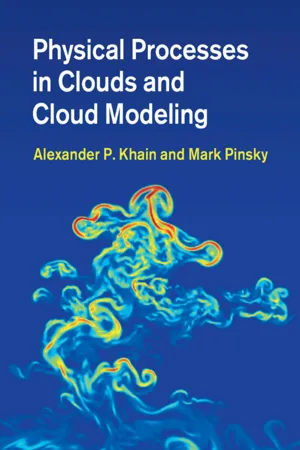
- English
- PDF
- Available on iOS & Android
Physical Processes in Clouds and Cloud Modeling
About this book
This book presents the most comprehensive and systematic description currently available of both classical and novel theories of cloud processes, providing a much-needed link between cloud theory, observation, experimental results, and cloud modeling. This volume shows why and how modern models serve as a major tool of investigation of cloud processes responsible for atmospheric phenomena, including climate change. It systematically describes classical as well as recent advancements in cloud physics, including cloud-aerosol interaction; collisions of particles in turbulent clouds; and the formation of multiphase cloud particles. As the first of its kind to serve as a practical guide for using state-of-the-art numerical cloud models, major emphasis is placed on explaining how microphysical processes are treated in modern numerical cloud resolving models. The book will be a valuable resource for advanced students, researchers and numerical model designers in cloud physics, atmospheric science, meteorology, and environmental science.
Frequently asked questions
- Essential is ideal for learners and professionals who enjoy exploring a wide range of subjects. Access the Essential Library with 800,000+ trusted titles and best-sellers across business, personal growth, and the humanities. Includes unlimited reading time and Standard Read Aloud voice.
- Complete: Perfect for advanced learners and researchers needing full, unrestricted access. Unlock 1.4M+ books across hundreds of subjects, including academic and specialized titles. The Complete Plan also includes advanced features like Premium Read Aloud and Research Assistant.
Please note we cannot support devices running on iOS 13 and Android 7 or earlier. Learn more about using the app.
Information
Table of contents
- Cover
- Half-title
- Title page
- Copyright information
- Table of contents
- Preface
- List of Abbreviations
- List of Symbols
- 1 Clouds: Definitions and Significance
- 2 Cloud Particles and Their Representation in Cloud Models
- 3 Basic Equations
- 4 Numerical Methods Used in Cloud Models
- 5 Warm Microphysical Processes
- 6 Microphysical Processes in Ice and Mixed-Phase Clouds
- 7 Modeling: A Powerful Tool for Cloud Investigation
- Appendix A Tensors
- Appendix B Collision Efficiency between Drops and Turbulent Enhancement Factor
- Appendix C Graupel-Drop Collision Efficiency and Kernel
- Index